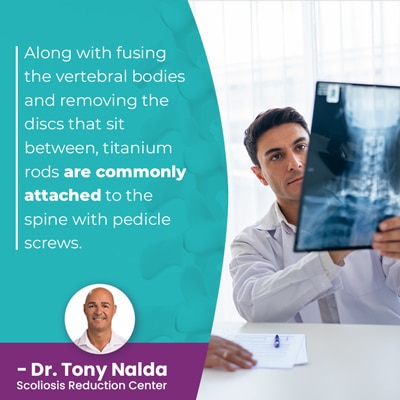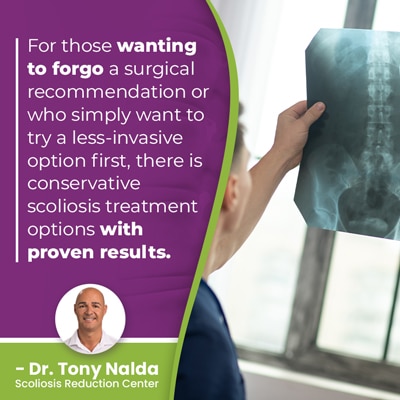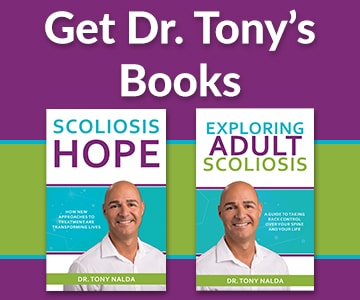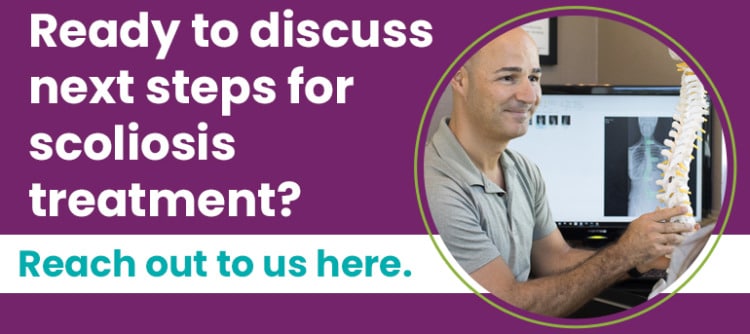Titanium Rods in Scoliosis Surgery: Benefits and Risks

Titanium rods are used in scoliosis surgery to secure the spine's position, and they are permanent. If there is any type of hardware failure, which is rare but does happen, the only recourse is a revision surgery, and the risks increase with each subsequent procedure and increasing age.
There are always risks associated with any surgical procedure, and when it comes to scoliosis surgery, risks can include infection, excessive blood loss, nerve damage, and negative effects on long-term spinal health and function. Titanium rods are permanently attached to help secure the spine's alignment.
Scoliosis surgery isn't the only treatment option available, but it was the dominant choice for many years.
Table of Contents
Scoliosis Surgery
Scoliosis causes the spine to bend and twist unnaturally, and it introduces a lot of uneven forces to the entire body; a misaligned spine can cause a misaligned body.
Scoliosis surgery is a type of spinal fusion that involves identifying the curve's most-tilted vertebrae at its apex and fusing them into one solid bone; this is done so they can't become more unnaturally tilted over time.
As a progressive condition, the nature of scoliosis is to get more severe over time. Scoliosis can range from mild to moderate, severe and very severe, and progression is triggered by growth.
Progression means the size of the unnatural spinal curve is increasing, as are the condition's effects, and the more severe scoliosis is, the more likely future surgical intervention can be.
Scoliosis surgery has the goal of stopping conditions from progressing, while conservative nonsurgical treatment has the goal of correcting the scoliosis.
 Along with fusing the vertebral bodies and removing the discs that sit between, titanium rods are commonly attached to the spine with pedicle screws.
Along with fusing the vertebral bodies and removing the discs that sit between, titanium rods are commonly attached to the spine with pedicle screws.
The role of the rods is to hold the spine's position while the fusion heals and to permanently hold the spine in that position.
The issues with rods is that they can break, malfunction over time, and they are rigid.
Negative Effects of Titanium Rods
The spine's natural design is based on flexibility and movement; in fact, spinal flexibility is an indicator of overall spinal health.
If the spine is fused, it's already going to be excessively rigid at the fusion site, and adding metal rods to either side of the spine to maintain its alignment can introduce more rigidity to the spine and its surroundings.
A spine that's rigid can be painful, weaker, and more vulnerable to injury, and if a rod breaks over time or cracks, more surgery is needed.
A spine that's fused is fused for life, and metal rods are inflexible; they can't account for growing spines in children, hence the advent of growing rods.
Growing Rods
Remember, progression is triggered by growth, so not only do children face more potential progression than adults, they are also at risk for rapid-phase progression due to the unpredictable nature of pubescent growth spurts.
Growing rods can be attached to the spine in the same way as traditional titanium metal rods, but they can be lengthened in response to growth, and the spine isn't fused; the idea of growing rods is that they are attached to the spine to guide its position during growth, and if/when successful, and/or once skeletal maturity is reached, the rods can be removed.
After skeletal maturity has been reached and growing rods are removed, this is often when spinal fusion is performed, when necessary.
So an advantage of growing rods over titanium metal rods is that they are not permanent.
This approach allows for the spine to grow naturally, but it does involve facing the risks of multiple surgeries as the rods are adjusted during growth.
When it comes to spinal fusion, is there another option other than metal rods?
Vertebral Body Tethering
Traditional spinal fusion surgery has a place in the treatment of scoliosis, but there are also different approaches to fusing the spine and the hardware used.
When spinal fusion is performed with the use of flexible fibers instead of metal rods, this is referred to as anterior scoliosis correction and/or vertebral body tethering.
Vertebral body tethering can also account for growth as the tethers are attached to screws on the affected vertebrae, and the tension on the tethers can be adjusted based on how the spine is responding to growth and/or treatment.
So vertebral body tethering, like growing rods, addresses the concern about fusing a child's spine who is still growing.
The procedure of vertebral body tethering is also considered minimally invasive because it involves accessing the spine through small portals through which a scope and camera are passed so the surgeon can visualize the spine.
Then muscles are pushed aside, rather than cut through, to access the spine and attach the screws and tethers.
This muscle sparing approach is thought to be better for muscle health and recovery time.
Now what about scoliosis treatment that doesn't involve surgery?
Conservative Scoliosis Treatment: Surgical Alternative
 For those wanting to forgo a surgical recommendation or who simply want to try a less-invasive option first, there is conservative scoliosis treatment options with proven results.
For those wanting to forgo a surgical recommendation or who simply want to try a less-invasive option first, there is conservative scoliosis treatment options with proven results.
Every surgical procedure comes with risks, and the reality is that many cases of scoliosis don't need surgery, particularly with early detection and intervention.
There are no treatment guarantees, but when scoliosis is diagnosed while still mild, this is the best time to act; the curve will be small, mild, flexible, and responsive to treatment.
In addition, as significant progression hasn't yet occurred, the condition's effects are also mild so easier to improve/reverse.
At the mild level, some subtle postural changes can be common such as uneven shoulders and hips, and in adults, there can be pain due to compression, but the more severe, the more noticeable a condition's symptoms are likely to be.
Conservative scoliosis treatment has the goal of restoring the spine's alignment as this is what introduces uneven forces to the spine, its surroundings, and the entire body.
Conservative Treatment Options
Conservative treatment is innovative and integrative and combines multiple types of treatment for the best potential results.
Conservative treatment options include condition-specific chiropractic care that works towards repositioning the curve's most-tilted vertebrae back into alignment with the rest of the spine.
Physical therapy and scoliosis exercises are applied to strengthen the back muscles for more support, address any muscular imbalance, and improve posture.
Mirror image exercises are helpful as they can teach patients postural awareness: how to hold their spines and bodies to best counteract the unnatural spinal curve.
Being mindful of body positioning helps hold treatment results long term, and this also improves the body's overall symmetry and appearance, which is a primary concern for many adolescent patients.
Corrective bracing is another facet of childhood scoliosis treatment as growing spines are more malleable and can be highly responsive to bracing that pushes the spine into a corrective position, and bracing is helpful in the treatment of adult scoliosis in terms of spinal stability and short-term pain management.
Rehabilitation involves custom-prescribed home exercises so patients can further heal and stabilize their spines from home, and guidance on how to lead a spine- and scoliosis-friendly lifestyle are also important during the rehabilitative phase of treatment.
Conclusion
So what are the benefits of using titanium rods in scoliosis surgery? When successful, spinal fusion with metal rods can maintain the spine's position and alignment and stop scoliosis from progressing.
Some risks, however, include a spine that's rigid and painful, less flexible, weaker and more vulnerable to injury, and if the rod fails, more surgery is needed.
An alternative to traditional titanium rods are growing rods that are used in patients facing a lot of future growth as this allows for the rods to be adjusted as needed; the cons being multiple spinal surgeries for the adjustments to be made.
Vertebral body tethering is considered to be a minimally invasive type of spinal fusion surgery because it uses flexible tethers that are attached to the affected vertebrae to adjust tension on the spine based on how it's responding to growth and/or treatment.
Risks can include tether breakage, over-correction of the curve, and being unsuccessful at modulating the spine's growth.
What I really want patients, and their families, to understand is that if scoliosis is a question, surgery is not the only answer; in fact, conservative treatment has proven results that support how unnecessary scoliosis surgery can be.
Here at the Scoliosis Reduction Center®, patients benefit from a multifaceted treatment approach capable of impacting conditions on every level, so don't hesitate to reach out of guidance and support.
Dr. Tony Nalda
DOCTOR OF CHIROPRACTIC
After receiving an undergraduate degree in psychology and his Doctorate of Chiropractic from Life University, Dr. Nalda settled in Celebration, Florida and proceeded to build one of Central Florida’s most successful chiropractic clinics.
His experience with patients suffering from scoliosis, and the confusion and frustration they faced, led him to seek a specialty in scoliosis care. In 2006 he completed his Intensive Care Certification from CLEAR Institute, a leading scoliosis educational and certification center.
About Dr. Tony Nalda
 Ready to explore scoliosis treatment? Contact Us Now
Ready to explore scoliosis treatment? Contact Us Now





